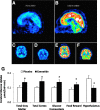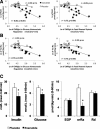Exenatide Regulates Cerebral Glucose Metabolism in Brain Areas Associated With Glucose Homeostasis and Reward System
- PMID: 26116695
- PMCID: PMC6908417
- DOI: 10.2337/db14-1718
Exenatide Regulates Cerebral Glucose Metabolism in Brain Areas Associated With Glucose Homeostasis and Reward System
Abstract
Glucagon-like peptide 1 receptors (GLP-1Rs) have been found in the brain, but whether GLP-1R agonists (GLP-1RAs) influence brain glucose metabolism is currently unknown. The study aim was to evaluate the effects of a single injection of the GLP-1RA exenatide on cerebral and peripheral glucose metabolism in response to a glucose load. In 15 male subjects with HbA1c of 5.7 ± 0.1%, fasting glucose of 114 ± 3 mg/dL, and 2-h glucose of 177 ± 11 mg/dL, exenatide (5 μg) or placebo was injected in double-blind, randomized fashion subcutaneously 30 min before an oral glucose tolerance test (OGTT). The cerebral glucose metabolic rate (CMRglu) was measured by positron emission tomography after an injection of [(18)F]2-fluoro-2-deoxy-d-glucose before the OGTT, and the rate of glucose absorption (RaO) and disposal was assessed using stable isotope tracers. Exenatide reduced RaO0-60 min (4.6 ± 1.4 vs. 13.1 ± 1.7 μmol/min ⋅ kg) and decreased the rise in mean glucose0-60 min (107 ± 6 vs. 138 ± 8 mg/dL) and insulin0-60 min (17.3 ± 3.1 vs. 24.7 ± 3.8 mU/L). Exenatide increased CMRglu in areas of the brain related to glucose homeostasis, appetite, and food reward, despite lower plasma insulin concentrations, but reduced glucose uptake in the hypothalamus. Decreased RaO0-60 min after exenatide was inversely correlated to CMRglu. In conclusion, these results demonstrate, for the first time in man, a major effect of a GLP-1RA on regulation of brain glucose metabolism in the absorptive state.
Trial registration: ClinicalTrials.gov NCT01588418.
© 2015 by the American Diabetes Association. Readers may use this article as long as the work is properly cited, the use is educational and not for profit, and the work is not altered.
Figures



References
-
- van Bloemendaal L, Ten Kulve JS, la Fleur SE, Ijzerman RG, Diamant M. Effects of glucagon-like peptide 1 on appetite and body weight: focus on the CNS. J Endocrinol 2014;221:T1–T16 - PubMed
-
- Alvarez E, Martínez MD, Roncero I, et al. . The expression of GLP-1 receptor mRNA and protein allows the effect of GLP-1 on glucose metabolism in the human hypothalamus and brainstem. J Neurochem 2005;92:798–806 - PubMed
-
- Nauck MA, Vardarli I, Deacon CF, Holst JJ, Meier JJ. Secretion of glucagon-like peptide-1 (GLP-1) in type 2 diabetes: what is up, what is down? Diabetologia 2011;54:10–18 - PubMed
-
- Campbell JE, Drucker DJ. Pharmacology, physiology, and mechanisms of incretin hormone action. Cell Metab 2013;17:819–837 - PubMed
Publication types
MeSH terms
Substances
Associated data
Grants and funding
LinkOut - more resources
Full Text Sources
Other Literature Sources
Medical
Research Materials

